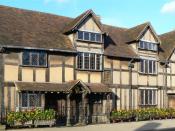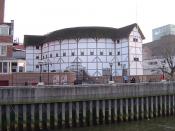William Shakespeare, surely the world's most performed and admired playwright, was born in April, 1564 in Stratford-upon-Avon, Warwickshire, about 100 miles northwest of London. According to the records of Stratford's Holy Trinity Church, he was baptised on April 26. Since it was customary to baptise infants within days of birth, and since Shakespeare died 52 years later on April 23, and--most significantly--since April 23 is St. George's day, the patron saint of England, it has become traditional to assign the birth day of England's most famous poet to April 23. As with most sixteenth century births, the actual day is not recorded.
Shakespeare's parents were John and Mary Shakespeare, who lived in Henley Street, Stratford. John, the son of Richard Shakespeare, was a whittawer (a maker, worker and seller of leather goods such as purses, belts and gloves) and a dealer in agricultural commodities. He was a solid, middle class citizen at the time of William's birth, and a man on the rise.
He served in Stratford government successively as a member of the Council (1557), constable (1558), chamberlain (1561), alderman (1565) and finally high bailiff (1568)--the equivalent of town mayor. About 1577 John Shakespeare's fortunes began to decline for unknown reasons. There are records of debts. In 1586 he was replaced as alderman for shirking responsibilities, and in 1592 was reprimanded for not coming to church for fear of process of debt.
Mary was the daughter of Robert Arden and had in total eight children with John Shakespeare. William was the third child but the first son. In 1583 Will Shakespeare's first daughter was born, Susanna and two years later he and his wife were blessed with twins. One boy and one girl named Hamnet and Judith.
COMEDY
All's Well That Ends Well
As You Like It
The Comedy of Errors
Cymbeline
Love's Labours Lost
Measure for Measure
The Merry Wives of Windsor
The Merchant of Venice
A Midsummer Night's Dream
Much Ado About Nothing
Pericles, Prince of Tyre
Taming of the Shrew
The Tempest
Troilus and Cressida
Twelfth Night
Two Gentlemen of Verona
Winter's Tale
HISTORY
Henry IV, part 1
Henry IV, part 2
Henry V
Henry VI, part 1
Henry VI, part 2
Henry VI, part 3
Henry VIII
King John
Richard II
Richard III
TRAGEDY
Antony and Cleopatra
Coriolanus
Hamlet
Julius Caesar
King Lear
Macbeth
Othello
Romeo and Juliet
Timon of Athens
Titus Andronicus
Shakespeare's chief source of inspiration would have come from his muse. His muse would have most likely been his lover, children or a good friend. Shakespeare's sonnet #38 is written about/to/for his muse.
In 1599, William Shakespeare and six associates became owners of the Globe, a new outdoor theatre in the London suburb of Southwark. The Globe was one of the largest theatres in London. It may have held as many as 3,000 spectators. Unfortunately the theatre burnt down in 1613, however it was immediately rebuilt. Shakespeare performed his plays in the Globe until 1642 when the Puritans closed it.
The new Shakespeare's Globe Theatre is along the River Thames. Recently, it has been restored to its former glory. The playhouse was officially inaugurated by Her Majesty the Queen on Thursday 12 June 1997. The original theatre was faithfully recreated by using the exact same materials. Therefore, you can feel the atmosphere of the age in which Shakespeare lived. The theatre doesn't have a roof; it is an open air theatre. Back then many people if not all did not bathe regularly so you could imagine the smell they would sometimes carry around with them, instead they would perfume their body and garments. Therefore, when a play was presented, all the windows were opened. However, now there is heavy traffic on the streets, so every window is closed when a play is in progress.
The time in which Shakespeare lived is called the Elizabethan period as Queen ElizabethI was ruling England at the time.
Southwark, on the south bank of the River Thames in London, was the area where Elizabethans went for fun, often illegal fun. This area was full of theatres, bear-baiting arenas, brothels (known more commonly as stews), bowling alleys and pubs or taverns. These were all places to get drunk and rowdy; where fights would break out and where pickpockets or cutpurses would make their livings. There was no police force in those days, although every parish had a night watch. The night watch seems generally to have been regarded as a group of bumbling fools and are often made fun of by Shakespeare in his plays. However, if thieves were caught by the night watch, or more likely by ordinary citizens, the punishments were very severe - thieves could be hanged or mutilated (for example by having a hand cut off) and prostitutes (known as whores or punks) were publicly whipped.
There were many different types of taverns. At the
bottom of the market were the alehouses. These were second homes for thieves, vagrants and prostitutes. At the top end of the market, there were posh clubs for men with titles and money. In the middle of the scale were the citizens' ordinaries, which were like a working mans' pub where you could buy food and beer. Shakespeare is likely to have spent a lot of time in citizens' ordinaries while he lived in London. Not only could he have bought food and drink and socialized in them but he may have done some of his writing there, using their light - much cheaper than buying his own oil and candles. In all the taverns, games of dice and cards were played, as well as board games like chess and draughts. All such games tended to involve gambling and where there was gambling there were tricksters and con-men and hustlers ready to use loaded dice and many other ways of cheating fools or 'gulls' out of their money.
Bull baiting, bear baiting and cock fighting were very popular entertainments. Queen Elizabeth herself often watched and enjoyed them. In bear baiting, a bear would be chained to a post, still able to move. Dogs
were then sent to attack the bear and the 'entertainment' was in watching the fight between bear and dogs. Bull baiting was very similar. In cock fighting,
two cockerels were put together and left to fight until one killed the other. Other animals were also used for these entertainments - there were accounts of
monkeys being put on horseback while dogs were set to chase the horse until the monkey fell off and was attacked by them. Although the animals obviously suffered a great deal, they were often not killed (except for the cockerels) simply because they were expensive to replace.
Hunting formed the basis of leisure time pursuits for all classes. The gentry (wealthy Elizabethans) hunted deer and enjoyed falconry. The lower classes hunted other animals, mainly foxes, badgers, otters and squirrels. They would also shoot or trap birds and spend time in hare coursing and fishing. Other sports included fencing, tennis and swimming, for the upper classes, and archery and football for the lower classes.
The higher up you were in society, generally, the more money you had, so nobles could afford to dress in silks, velvets and furs. Commoners with less disposable income wore wool and linen. However, as the mercantile classes grew richer and more numerous, the demand for imported luxuries such as silk from China, increased to the point where balance of payments issues started to pre-occupy the rulers of many European countries. The answer to the outflow of money from their realms was for monarchs to enact ' SUMPTUARY' laws which decreed the appropriate dress and materials which each social class was allowed to wear. The laws had two objectives, firstly, to restrict importation of costly materials and secondly, to pacify nobles who objected to the sight of mere tradesmen decked out in furs and silks. These laws were more honoured in the breech than the commission partly due to the habit of noblemen passing on their cast off clothing to their servants who sold it or wore it themselves.
Despite protestations of blue blooded aristocrats to the contrary, money has always mattered and due to a lack of other portable status symbols such as prestige cars or private jets, if you wanted to flaunt your wealth, you wore rich dress and jewellery. If you were seriously rich you would dress your retinue in costly materials as well.
Next to the skin, a shift or chemise should be worn by both sexes, if they could afford it. For the rich ,silk could be used, but mostly linen or wool were the materials used. Apart from it's contribution to the warmth of the wearer the garment's function was to absorb sweat and any other bodily secretion, there by keeping the outer clothing clean. In the days prior to dry cleaning the only cleaning that velvet gowns or doublets got was brushing or sponging with a lightly dampened cloth, so care was taken to try to keep them clean.
Food and drink were a major part of life in Elizabethan times. People had three main meals per day. Breakfast was the first and most important meal of their day. The people of this time ate a variety of different foods and had many creative ways of preparing them. The people also had distinct table manners.
In eating breakfast, many people wanted a fine diet. Instead of eating normal bread, many ate manchets. Manchet was a round loaf that weighed about six pounds after it was cooked. It was browner than normal bread. When bread was eaten in the morning, butter was used to flavour it so that the bread was not so boring. Children often ate butter in Lent. However, adults who kept the fast strictly avoided butter during this time. Eggs were also eaten at breakfast. They were eaten "sunny side up" or beaten to make scrambled eggs. They were also mixed with breadcrumbs to fry things such as fish. Another popular food for breakfast was pancakes, which were made from flour and egg batter. They were a treat for Sunday mornings. Elizabethans usually put jams such as grape, strawberry, and sometimes powdered sugar on them for a sweeter taste. Breakfast, the hardiest of all their meals, gave a healthy start to their day.
In earlier times, water was the main beverage. However, as farmers became more important, other drinks came along also. Milk was known for building healthy bones and giving a refreshing taste after a dessert. Farmers got milk from cows and goats. Other beverages were created from a wine base. Another popular wine base drink was a caudle, a hot drink thickened with eggs and drunk at breakfast or at bedtime.
There were many differences between the meals of the higher and lower classes. Dinner was the most important meal for any class and came usually from 10:00 a.m. till noon. Ploughmen were well scrubbed and usually ate at bare tables. Country table manners were not the daintiest. In a well-to-do household, however, a greater ceremony was observed. There was a cloth placed upon the table. Next, a trencher, a napkin, and a spoon were set at every place. Elizabethans loved fine linens.
An Elizabethan dinner usually consisted of several kinds of fish, half a dozen different kinds of game, venison, various salads, vegetables, sweet meats, and fruits. Rich men usually served food that suited them. Most had noted French chefs to prepare their meals. Many had a very moderate diet. Guests at a pleasant dinner table were offered oysters with brown bread, salt, pepper, and vinegar.
Guests were able to choose between roast beef, powder (salted) beef, veal and a leg of mutton with a "galandine sauce." There was often a turkey, boiled capon, a hen boiled with leeks, partridge, pheasants, larks, quails, snipes, and woodcock, in addition to the other foods. Salmon, sole, turbot, and whiting, with lobster, crayfish, and shrimps, were set before dinner guests. Young rabbits, leverets, and marrow on toast tempted those who did not care for the gross meats. Artichokes, turnips, green peas, cucumbers and olives were provided as vegetables. Attractive salads, including one of violet buds, were also served as vegetables. Finally, the host or hostess would usually offer guests quince pie, tart of almonds and various fruit tarts. They would also be offered several kinds of cheese and desserts, including strawberries and cream.
The midday meal in a good citizen's home consisted of certain coarser foods like sausage, cabbage (usually badly cooked) and porridge for the children. It was customary to spend two to three hours over this chief meal of the day. The nobility, gentleman, and merchantmen commonly sat at the board till 2:00 or 3:00 in the afternoon. Country fare was given with fat capon or plenty of beef and mutton. They also received a cup of wine or beer. In the holiday season, rich and poor alike indulged in leisure time and feasting.
People in the middle and lower classes ate lots of potages and stews. They also had fish and vegetables at dinner. Behind the first cooked potages was the tradition of food processing. This consisted of soaking roots, leaves, seeds, nuts, and berries in cold water. They were soaked several hours in order to soften them, which made them easier to digest.
Next, the pot boiler method was used for cooking meat in water to make it more tender. Potage was made primarily from cereals and large weed seeds, which were roughly ground into bits and pieces.
Altogether there were many things to eat during this period. Overall the diet was much healthier than what many people may eat now.
When going to watch theatre, people would pay around ã5 to stand and watch the performance from the yard, the modern equivalent of the penny paid by Shakespeare's groundlings, you can stand and have the closest view of the actors that you will ever get in any theatre. On the balcony you might see musicians or members of the audience (in Shakespeare's day, the richer patrons, now mostly guests of the company). On the Left and right of the stage, on the middle gallery, are the Gentlemen's Rooms, the Renaissance equivalent of corporate boxes, which also provide the most comfortable seating.
William Shakespeare started writing tragedies because he thought the tragic plots used by other English writers were lacking artistic purpose and form. He used the fall of a notable person as the main focus in his tragedies. Suspense and climax were an added attraction for the audience. His work was extraordinary in that it was not of the norm for the time. A reader with even little knowledge of his work would recognize one of the tragedies as a work of Shakespeare.
A hero today is seen as a person who is idolized. Nowadays, a hero does not have to have wealth or certain political beliefs, but instead can be regarded as a hero for his/her actions and inner strength. However, in the plays of Shakespeare, the tragic hero is always a noble man who enjoys some status and prosperity in society but possesses some moral weakness or flaw which leads to his downfall. External circumstances such as fate also play a part in the hero's fall. Evil agents often act upon the hero and the forces of good, causing the hero to make wrong decisions. Innocent people always feel the fall in tragedies, as well.
The four most famous Shakespeare tragedies are King Lear, Hamlet, Othello, and Macbeth.
Romeo and Juliet is one of Shakespeare's most well know plays through out the world. It's the common tale of two lovers who could never be together due to their family's stubbornness. Set in Verona, Italy, the story of Romeo and Juliet is both a romance and a tragedy. What makes it the biggest tragedy of all is that if Romeo had waited just seconds longer at the altar where Juliet's body lay asleep he would have seen her wake up and therefore not kill himself. If this had of been the case then Juliet too would of lived and maybe perhaps unite the two families after years of feud. However, this did not happen as Romeo and Juliet is more tragedy then fairytale. As it is said, 'it is better to have loved and lost than to have never loved at all.'


